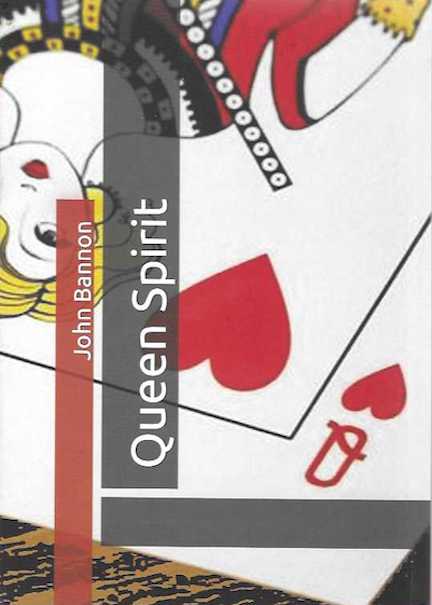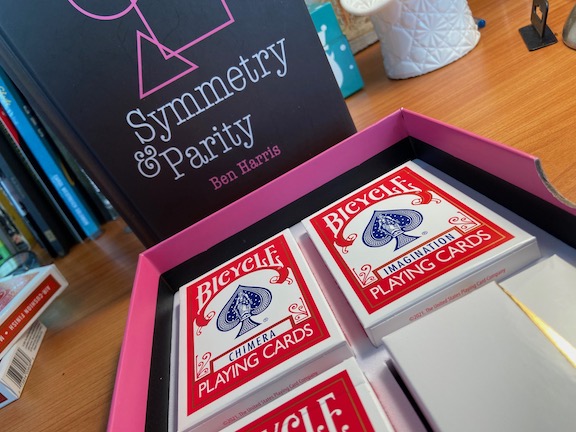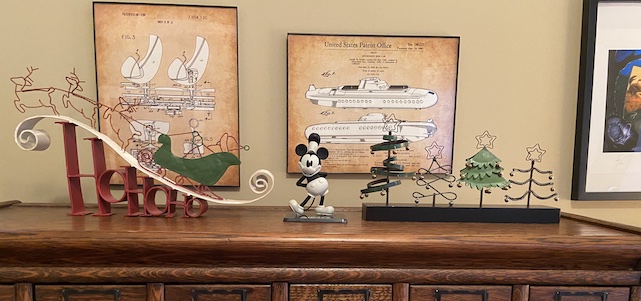
We dive into John Bannon’s study of four-queen assemblies with seven cards, recall last-month’s extraordinary Bannon four-queen trick from Genii, , and, for the record, recall our favorite four-queen trick with eleven cards.
MAGNIFICENT SEVEN — John Bannon’s latest hardback, Queen Spirit, is unique in the universe of card trick collections. Specifically, it showcases seven-card assemblies that involve four queens and three spot cards. Despite that constraint, the diversity of plots is impressive.

There are eight. Check them out:
Queen’s Landing uses the Braue Addition to achieve an all-at-once transposition of the spot cards with three queens. . John introduces a perfect girl band patter theme that runs through most of the tricks. This is the easiest trick in the book, and I found myself doing it nonchalantly as I read the remaining routines.
Queen of My Block uses a a block turnover to achieve the same result. The two routines would play well together.
Rehab is more complicated, more magical. Following an initial transposition, you are left with three face-down cards in a row, presumably the spot cards. You show the four queens in your hand, deal one face down onto the center cof the tabled row, and sandwich it with the left-hand tabled card. The right-hand tabled card is placed face-down when among the three face-up queens. where it becomes the fourth, and the sandwich cards are now all spot cards. This is fun to watch.
Band on the Run s a one-at-a-time assembly. One of the spot cards is the chosen card. Repeatedly, it is dealt from the hand to the table and the hand get a face-down queen. But the chosen card is back in the performer’s hand and the dealt “chosen” card is now a queen itself. My old friend, Al Leech’s Snide, makes the last transposition look cool.
Otis and he Queens is my favorite of the book. The queens begin in a face-up row on the table and are turned face down in position. Really. One at a time. a queen is placed face down into the middle of a face-down spread of spot crds. It rises to the top, elevator style, and is then dealt face down back into position on the table. After the fourth queen rises, all the cards in the hand are show to e queens, and the tabled cards are the spot cards. The band is back together, and the fans go wild.
Otis, of course, is a brand of elevator.
Alt: Block Party is another instant transposition, thanks again to an early block turnover.
Ninja Assembly is a more normal construction. Four piles of three cards each are clearly shown, each card front and back. A queen is dealt onto each pile. three of the piles are combined into one packet and riffled at the fourth. The fourth contains all the queens, the band together again.
Blitzen is a snappy production of four queens. With one cut the deck is split into four piles, three with face-up queens on top and one with a facd-down card. Could that card be the missing queen? Of course!
In these studies John bannon pays close attention to what the spectator thinks, to whether he will or not be surprised, especially in a one-at-a-time effect. Subtle convincers are built into most of the tricks, and the patter keeps them enjoyable.
Queen Spirit is a hardback from Vanishing, Inc., 74 pages, $39.95. Its complete title, (Smells Like) Queen Spirit, didn’t ring a bell with me, but I take it on good authority from Maleficent and Michael Perovich that it is probably a takeoff on “Smells Like Teen Spirit” by Nirvana.
Rock on.
LOOKS LIKE QUEEN SPIRIT — The John Bannon trick mentioned last month could have earned place in this book. To quote from that review:
And speaking go Genii, one of my go-to columns is John Bannon’s “Dealing with It.” In December he knocked it out of the park with Con-ttourage, a takeoff on Gordon Bean’s Entourage. The magi displays four face-down cards sandwiched between two face-up black jacks. The spectator imagines the face-down cards to be queens, and one by one eliminates them, suit by suit, until only the imagined queen of hearts remains. It is turned face up, shown to be the actual queen of hearts, and is then dealt face down to the table with the other face-down queens. They are turned up and shown to be not queens but aces, and the queen of hearts turned up and shown to be the final ace. The jacks are spread and a face-down queen of hearts lies between them.
Secretly, although the trick involves four queens, they are not all queens, and secretly the routine uses seven cards, not six.
VACATIONS LIKE QUEEN SPIRIT — Speaking of tricks that use four queens, my favorite involving eleven cards is Jim Steinmeyer’s Traveling Companions, from Bewildering Impuzzibilities. Check our July issue for a recent mention of this completely self-working trick.

SVENGALI ON STEROIDS -- In the comics, Mandrake could create marvelous magic with a hypnotic gesture. Those familiar with a Svengali deck know that marvelous magic is almost that easy, hence it is surprising that someone had not already done what Ben Harris has done. Ben has completely reconsidered, deconstructed, and rebuilt the Svengali deck to amazing new purpose.

Symmetry, Parity, and the Chimera Deck is a handsomely boxed kit, featuring a 130-page hardback, Symmetry & Parity along with three groundbreaking gimmicked decks and a color-neutral card case to hold them. Presentation includes one of the most convincing shuffle sequences ever, a patter nod to the math that claims the shuffled deck lies in one of eight thousand, billion billion billion billion billion billion billion configurations, another to Douglas Adams, and more. The Parity Deck allows an mazing six-phase routine involving impossible arrangements of red and black cards. The Chimera Deck allows a face card to be freely selected and tabled, then the deck shown to be both all red and all blue-backed cards. Which is the selection? Another color entirely! The Imagination Deck is similar to the Chmiera but allows you to show the deck as blank faced, then as cards fading into being, and then as completely printed.
Although the book provides instruction on how to create the decks from scratch, you will be thrilled to have the work done for you. The book is lovely, written by Ben Harris, edited by Steve Shufton, delightfully illustrated by Ever Elizalde, and designed by Ben Harris and Andi Gladwin. The entire package is luscious, like something shiny and new and substantial from Apple. It feels like quality, and it is. $75 from Vanishing Inc.






